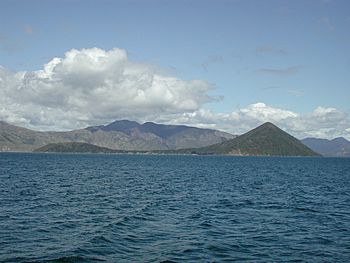Maud Island facts for kids
|
Māori: Te Hoiere
|
|
|---|---|

Maud Island viewed from northeast
|
|
| Geography | |
| Location | Pelorus Sound |
| Coordinates | 41°02′S 173°53′E / 41.033°S 173.883°E |
| Length | 3.5 km (2.17 mi) |
| Highest elevation | 368 m (1,207 ft) |
| Administration | |
| Demographics | |
| Population | 0 |
Maud Island, also called Te Hoiere in the Māori language, is a special island in New Zealand. It is one of the larger islands found in the Marlborough Sounds. This area is at the northern tip of the South Island. Maud Island covers about 320 hectares (790 acres) and is a very important place for protecting rare animals.
Contents
A Safe Home for Rare Animals
Maud Island is a very important nature reserve. It is officially called a Scientific Reserve because it helps protect endangered species. The island is kept free from predators like stoats or rats, which can harm native wildlife. Because of this, only scientists and people working in conservation are allowed to visit. If you want to go there, you need a special permit from the New Zealand Department of Conservation.
Saving the Kakapo
In 1974, a very rare bird called the kakapo was brought to Maud Island. This happened thanks to the efforts of a conservationist named Don Merton. Kakapo are large, flightless parrots that are critically endangered. Maud Island was a safe place for them to live and breed without danger from predators.
Later, more kakapo were moved to other safe islands. These included Codfish Island, Anchor Island, and Little Barrier Island. This helped to spread the population and keep them safe.
In 1998, a pair of kakapo named Flossie and Richard Henry had three chicks on Maud Island. However, the kakapo population was later moved from Maud Island to islands with more forests. This was to give them an even better home.
Protecting the Takahē
Another rare bird, the takahē, was also brought to Maud Island in 1985. Takahē are large, flightless birds that look a bit like giant pukeko. They were once thought to be extinct but were rediscovered in 1948. Maud Island helped provide a safe place for them to recover.
Unique Frogs and Insects
Maud Island is also home to the Maud Island frog (Leiopelma pakeka). This tiny frog is very special. It was once thought to be the same as the Hamilton's frog but was recognized as its own species in 1998.
The island also has many interesting insects. You can find different types of weta, which are large, cricket-like insects. These include tree weta, cave weta, and the huge Cook Strait giant weta. These weta are often seen at night.
Other cool insects on the island include the large flax weevil, which lives on flax plants. The rare Cook Strait click beetle also lives on Maud Island.
Island Names
Maud Island has two official names. The first is Maud Island, and the second is Te Hoiere. Both names were officially recognized in 1948. Te Hoiere is the island's name in the Māori language.

